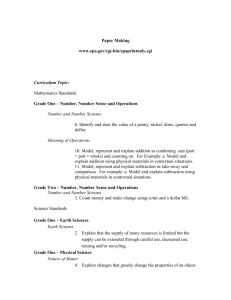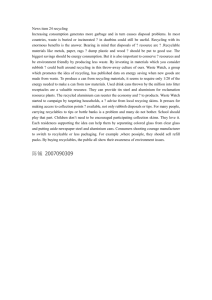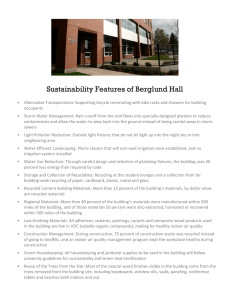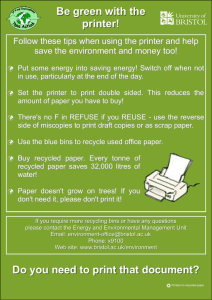Document 11116781
advertisement
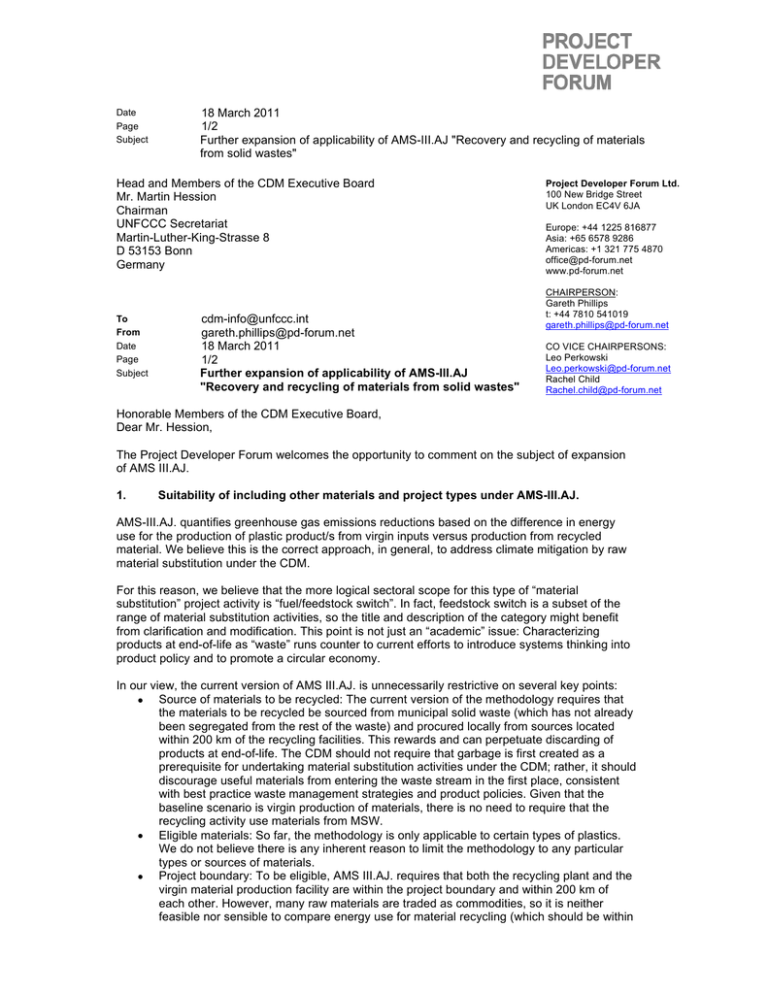
Date Page Subject 18 March 2011 1/2 Further expansion of applicability of AMS-III.AJ "Recovery and recycling of materials from solid wastes" Head and Members of the CDM Executive Board Mr. Martin Hession Chairman UNFCCC Secretariat Martin-Luther-King-Strasse 8 D 53153 Bonn Germany To From Date Page Subject cdm-info@unfccc.int gareth.phillips@pd-forum.net 18 March 2011 1/2 Further expansion of applicability of AMS-III.AJ "Recovery and recycling of materials from solid wastes" Project Developer Forum Ltd. 100 New Bridge Street UK London EC4V 6JA Europe: +44 1225 816877 Asia: +65 6578 9286 Americas: +1 321 775 4870 office@pd-forum.net www.pd-forum.net CHAIRPERSON: Gareth Phillips t: +44 7810 541019 gareth.phillips@pd-forum.net CO VICE CHAIRPERSONS: Leo Perkowski Leo.perkowski@pd-forum.net Rachel Child Rachel.child@pd-forum.net Honorable Members of the CDM Executive Board, Dear Mr. Hession, The Project Developer Forum welcomes the opportunity to comment on the subject of expansion of AMS III.AJ. 1. Suitability of including other materials and project types under AMS-III.AJ. AMS-III.AJ. quantifies greenhouse gas emissions reductions based on the difference in energy use for the production of plastic product/s from virgin inputs versus production from recycled material. We believe this is the correct approach, in general, to address climate mitigation by raw material substitution under the CDM. For this reason, we believe that the more logical sectoral scope for this type of “material substitution” project activity is “fuel/feedstock switch”. In fact, feedstock switch is a subset of the range of material substitution activities, so the title and description of the category might benefit from clarification and modification. This point is not just an “academic” issue: Characterizing products at end-of-life as “waste” runs counter to current efforts to introduce systems thinking into product policy and to promote a circular economy. In our view, the current version of AMS III.AJ. is unnecessarily restrictive on several key points: • Source of materials to be recycled: The current version of the methodology requires that the materials to be recycled be sourced from municipal solid waste (which has not already been segregated from the rest of the waste) and procured locally from sources located within 200 km of the recycling facilities. This rewards and can perpetuate discarding of products at end-of-life. The CDM should not require that garbage is first created as a prerequisite for undertaking material substitution activities under the CDM; rather, it should discourage useful materials from entering the waste stream in the first place, consistent with best practice waste management strategies and product policies. Given that the baseline scenario is virgin production of materials, there is no need to require that the recycling activity use materials from MSW. • Eligible materials: So far, the methodology is only applicable to certain types of plastics. We do not believe there is any inherent reason to limit the methodology to any particular types or sources of materials. • Project boundary: To be eligible, AMS III.AJ. requires that both the recycling plant and the virgin material production facility are within the project boundary and within 200 km of each other. However, many raw materials are traded as commodities, so it is neither feasible nor sensible to compare energy use for material recycling (which should be within 18 March 2011 2/2 Further expansion of applicability of AMS-III.AJ "Recovery and recycling of materials from solid wastes" Date Page Subject the project boundary) vs. energy use for virgin production from a single local facility. In such cases, it is preferable to consider broader benchmarks for energy use in virgin material production, and we therefore welcome the invitation to comment on appropriate default values below. 2. Methods to show product equivalence of recycled and virgin materials No input on this. 3. Default values for embedded emissions/energy in other materials We support the use of conservative default values to determine carbon dioxide emissions reductions from scrap recycling relative to the baseline of virgin production. Such default values typically draw on life-cycle inventories compiled by industry associations and/or research institutions. At this time, we can suggest global default values for the following additional materials: • Steel: 1.5 t CO2–eq reduced per ton of scrap steel recycled (this parameter is referred to as the “scrap LCI”). The default value is based on the extensive life-cycle inventory (LCI) database maintained by the World Steel Association (the IISI Worldwide LCI Database for Steel Industry Products). The methodology, results and interpretation of the LCI study for 2000 were subjected to a critical, third-party review, to ensure that the project was 1 consistent with the ISO14040 standard . • Aluminium: 8.5 t CO2–eq reduced per ton t scrap aluminium. The energy required to produce aluminium from scrap metal is approximately 5% of that required for primary production. Similar to the approach for steel, the International Aluminium Institute has compiled an ISO-compatible life-cycle inventory for aluminium, based on a global survey from 2005. Given that there is a global market for aluminium and that energy sources and technologies do not differ much globally, the global data is a good basis to assess leakage associated with recycled aluminium. According to this database, the global default value for t CO2 reduced per t aluminium recycled is 9.171 t CO2–eq / t recycled ingot, derived from the difference between the carbon dioxide equivalent emissions associated with producing one ton of primary ingot (9.677 t CO2–eq) and the corresponding emissions from producing one ton of recycled ingot from old scrap (0.506 t CO2–eq). Metal is lost during the melting process to produce secondary aluminium from scrap, so we assume the high end of the loss range cited by the IAI for consumer durables of 7%. Creating a CDM methodology that could incentivize the increased recycling of the full range of consumer goods at end of life to substitute for virgin raw materials would be a step towards a holistic and more scientific approach to consideration of net mitigation benefits of various product end-of-life treatments. It is important to ensure that the CDM sends the right signals to the market to adopt the lowest carbon pathways. We stand ready to support the work of the UNFCCC on related CDM issues. Kind regards, Gareth Phillips Chair of the PD Forum 1 ISO 14040 describes the principles and framework for life cycle assessment (LCA) including: definition of the goal and scope of the LCA, the life cycle inventory analysis (LCI) phase, the life cycle impact assessment (LCIA) phase, the life cycle interpretation phase, reporting and critical review of the LCA, limitations of the LCA, the relationship between the LCA phases, and conditions for use of value choices and optional elements.

